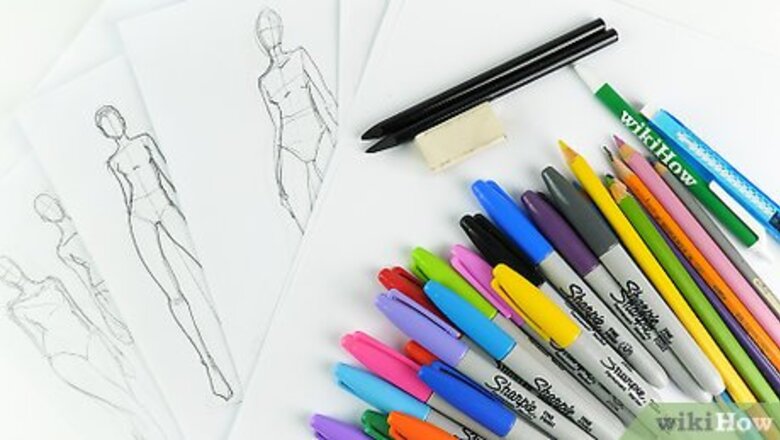
views
Starting Your Sketch
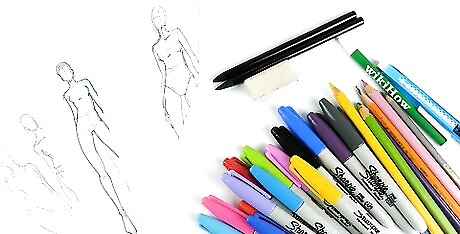
Gather materials. Choose a hard lead pencil (H pencils are best) that makes light, sketchy marks that are easy to erase. Marks made with these pencils also don't indent the paper, which is helpful when you want to add color to the image. A good quality eraser and thick paper are also important materials to have if you want your sketch to look professional. If you don’t have the right type of pencil, you can do a sketch with a number 2. Remember to make very light marks, rather than pressing hard on the page. Drawing in pen is not advisable since you won’t be able to erase it. You will also need colored markers, inks, or paints to illustrate your clothing designs.
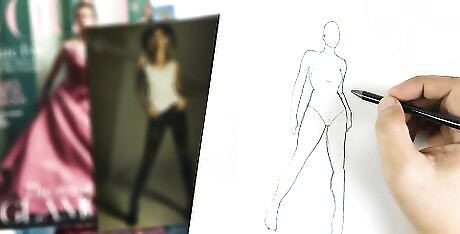
Consider alternate methods for creating a croquis. It's nice to be able to draw your croquis since it allows you to create a model to the exact proportions you want. However, if you want to jump straight to drawing your clothing designs, there are a few shortcuts you can opt to take: Download one online, where you'll find them in a range of shapes and sizes. For instance, you can download a croquis in the shape of a child, a man, a petite woman, and so on. Make a croquis by tracing the outline of a model from a magazine ad or another picture. Just place a piece of tracing paper over the model you like and lightly created an outline.
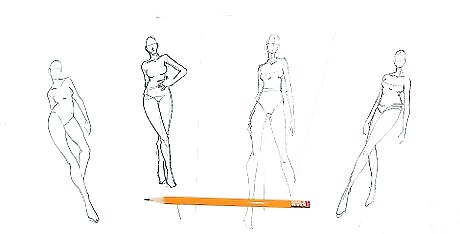
Decide on a pose for your croquis. The model for your design, called a croquis, should be drawn in a pose that will show off the items best. You can show the model walking, sitting, bending, or in any other position. As a beginner, you may want to start with the most common pose, which is a runway sketch that shows a model standing or striding on a runway. This is the easiest to draw and it will allow you to illustrate all of your designs in full view. Since you want to illustrate your designs in a way that makes them look professional and appealing, it's important to model them on croquis that is well-proportioned and well-drawn. Many fashion illustrators practice drawing hundreds of croquis to perfect their ability to create a variety of poses. EXPERT TIP David Reeves David Reeves Bespoke Tailor David Reeves is a Bespoke Tailor and the Founder of Reeves: Modern English Tailoring, based in New York City. David has been in the bespoke tailoring business for over 25 years and specializes in designing and creating custom, high-end suits. David has worked with influential names in the United Kingdom and the United States such as Richard James of Savile Row, Prada, Commes Des Garcons, and Timothy Everest. David Reeves David Reeves Bespoke Tailor Fashion sketches should communicate effectively to the intended audience. Fashion sketches are all about communication — they need to clearly convey the design idea to the intended audience. Whether it's a personal sketch for visualization or a professional presentation, focus on making it easy to understand rather than making it visually artistic. Clarity is key.
Drawing a Croquis
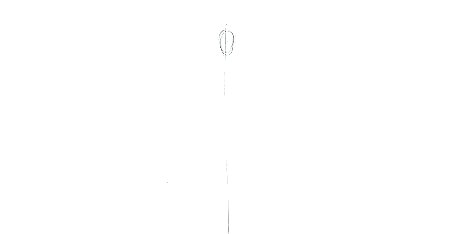
Draw the balance line. This is the first line of your sketch, and it represents your model’s center of gravity. Draw it from the top of the head to the tip of the toes, along the backbone of your croquis. Now draw an oval to represent the head. This is the base of your croquis, and from this, a proportional drawing can be made. You can think of the croquis as the skeleton of the model. The balance line should be a straight vertical line, even if you want the model to pose in a leaning position. For example, if you want the model to be posed with her hips tilted slightly to her left, draw a straight balance line in the middle of the page. You want this line to extend from the top of the model's head to the ground that she is standing on. Note that when you’re designing clothes, a proportional model isn't required, because the clothing is what is being showcased, not your figure drawing skills. Don’t worry too much about creating an accurate-looking model or adding features to the face.
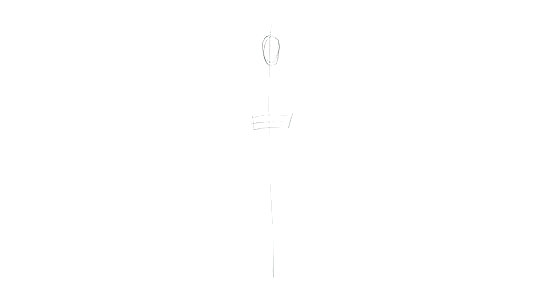
Start drawing the pelvic area first. Draw a square with equal side lengths on the balance line just below the middle, where the pelvis is naturally positioned on the body. Size the square according to how wide you want your model to be. A thinner model would have a smaller square width than a plus-sized model. Keeping your desired pose in mind, tilt this pelvic square either left or right. For example, if you want your model’s hips slanted to the left, tilt the square slightly to the left. If you want a normal standing model, just draw the square upright without any angles left or right.
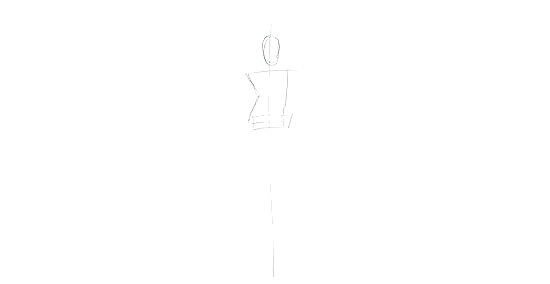
Draw the torso and shoulders. Extend the torso lines upward from the two corners of the pelvic square. The torso should extend upwards, bending in the midway at the waist and extending out again at the shoulder. As with a real human body, the shoulders should be the same width as the hips, or the top of the pelvic box. When you’re finished, the torso should look like a normal torso you would see on a body. Refer to pictures of models in magazines or advertisements for reference. Notice how the waist is smaller than the lower portion of the body and hips. The torso should measure about two heads in length. It’s common to sketch the shoulders and hips tilted in opposite directions, in a position called contrapposto, or counterpose. This gives the impression of movement. Draw the waist as a horizontal line that’s shorter than the shoulder and hips lines. Pay attention to bend lines (the curve of the rib cage, etc.) as those angles and lines are crucial to creating a figure that doesn't look like it has dislocated body parts.
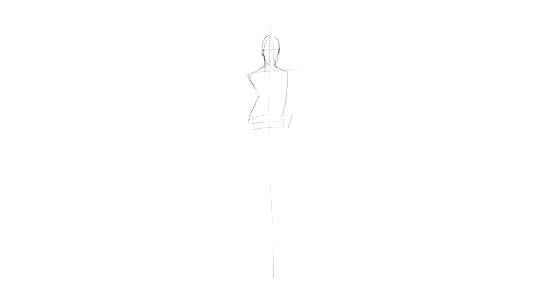
Sketch the neck and head. The model's neck should be a third the width of the shoulder and half the length ahead. After drawing this, sketch in the head, which should be in proportion to the body. The bigger the head, the more juvenile or younger the model looks. You can erase the initial oval you drew to represent the head. Draw the head so that it looks natural with the pose you have selected. You can tilt it slightly up or down, or to the right or left.

Fill in the legs. The legs should be the longest part of the body, the length of about four heads. The legs are also portioned into two pieces, the thighs (from the bottom of the pelvic box to the top of the knees) and calves (from the bottom of the knees to the beginning of the ankles). Keep in mind that fashion illustrators usually exaggerate the model's height by making her legs longer than her torso The top of each thigh should be approximately the same width as the head. Taper the width of each leg from the thigh to the knee. By the time you reach the knee, the leg should be one-third the width of the bigger portion of the thigh. To draw the calves, taper down to the ankles. Each ankle should be about one-fourth the width of the head.

Finish with the feet and arms. The feet are relatively narrow. Draw them like elongated triangles that are about the same length as the head. Construct the arms like the legs, tapered toward the wrists. Make them longer in proportion to the torso than a real person’s arms would be since this gives a more stylized impression. Add the hands and fingers last.
Drawing Clothes and Accessories
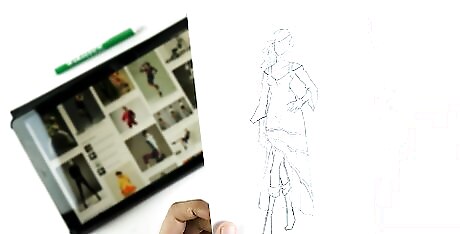
Illustrate your original design. Think about what look you’re trying to create, and represent it down to the last detail. If you’re designing a dress, for example, add patterns, ruffles, text, bows, and so on to create a beautiful piece. Focus on the elements of your design that are unique, and include appropriate accessories so that the style you’re going for is clear. If you need some fresh ideas or don't know where to start, look up fashion trends on the internet or in magazines for inspiration.
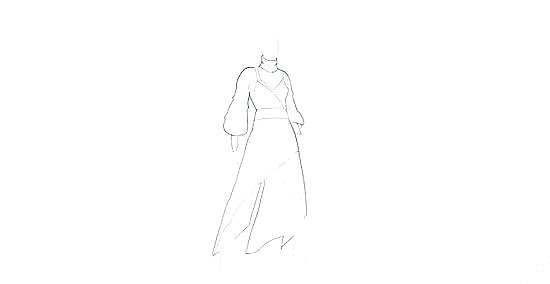
Sketch the clothes boldly. Since the purpose of a fashion drawing is to showcase your design ideas, use a bolder hand when you’re drawing the clothing. Sketch the clothes so that they appear to hang on the croquis realistically. There should be creases around the elbows and at the waist, as well as near the shoulders, ankles, and wrists. Think about how the clothing hangs on a person and replicate that on your model. Remember that different fabrics and structures lie on the body in different ways. If the fabric is thin and silky, it will rest on the body and drift away, almost billowing. If the fabric is thick like denim or wool, it will be boxier and will show less shape of the body (think denim jackets). Try to illustrate the texture of the fabric you’re drawing, whether it’s smooth, coarse, stiff, or soft. Add details like sequins and buttons to make the drawing look more realistic.
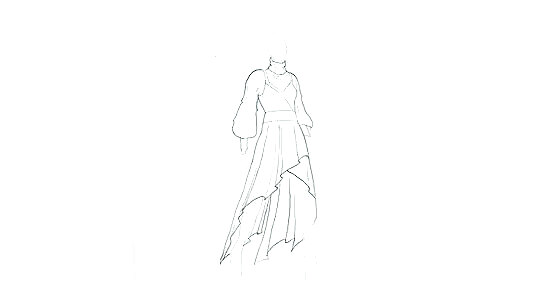
Learn how to draw folds, wrinkles, and pleats. Use different types of lines to create different creases in the fabric you're drawing. Knowing how to draw folds, wrinkles and pleats will help you illustrate the structure of the garment. Folds can be drawn using loose, wavy lines. Use circular patterns to show wrinkles. Take out a straight edge to draw exact pleats.
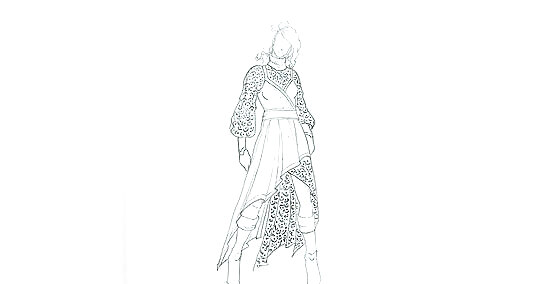
Illustrate patterns and prints. If your design includes a patterned or printed fabric, it's important to accurately illustrate how it will look on a model. Start by outlining the patterned garment, such as a skirt or blouse. Divide it into a grid with different sections. Fill in the sections one at a time with the pattern on the fabric. Pay attention to how folds, pleats, and wrinkles change the appearance of a pattern. It may need to bend or be cut off at certain points to look accurate. Take the time to draw the pattern in detail and make sure it looks the same across the entire grid.
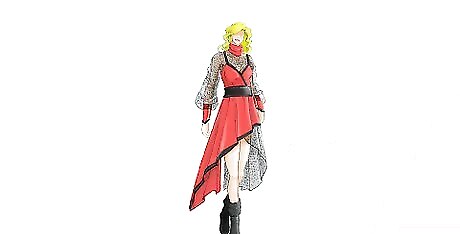
Finalize the drawing with shading, ink, and color. Use thick black ink or paint on the lines that you want to keep. You can erase the body shaping lines and any stray pencil marks at this point. Finally, carefully color in the clothing using hues you want your designs to have. You can color the clothing with markers, ink, or paint. Mix colors and use a variety of shades to illustrate your designs. imagine the design moving towards you under spotlights on a runway when you’re working on shading and texture. Deeper folds in a fabric will result in darker shades of the color you're using. Where fabric is hit by the light, the colors should appear lighter. Adding features like hair, sunglasses, and makeup is a nice final touch that will make your fashion sketch come to life.
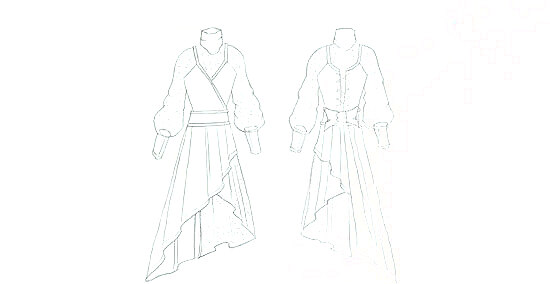
Consider making flats. In addition to making a fashion illustration, you may want to create a flat schematic. This is an illustration of your clothing design that shows the flat outline of the garment, as though it were laid out on a flat surface. It's helpful for people viewing the design to see the flat version as well as the way it would look modeled on a body. Flats should be drawn to scale. Make an effort to create illustrations that look as exact as possible. You should include a back view of your flats as well, especially if the back of the design includes unique details.

















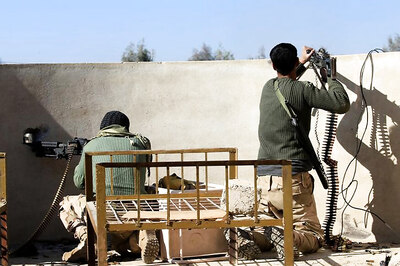
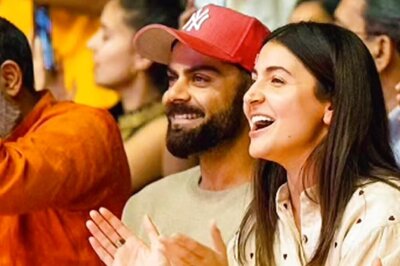
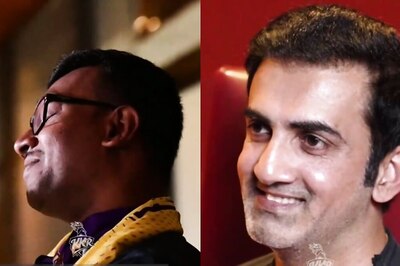
Comments
0 comment